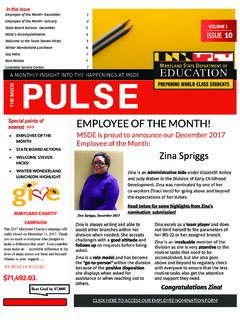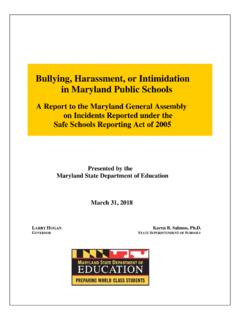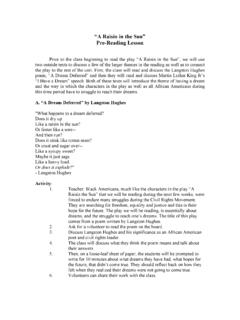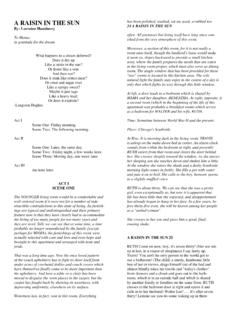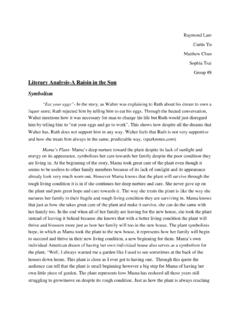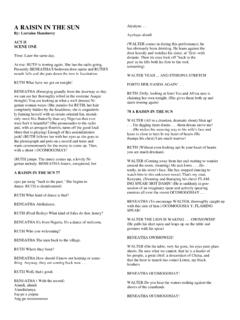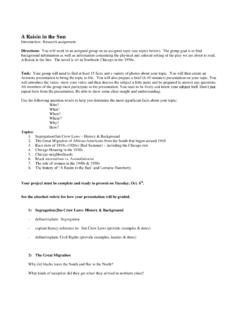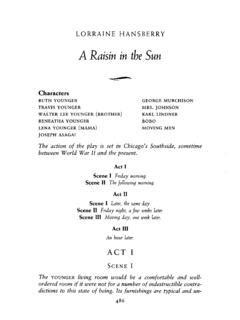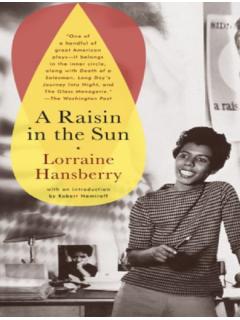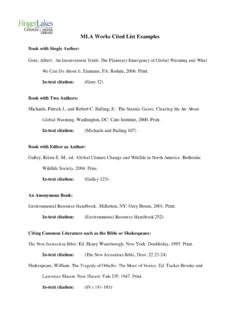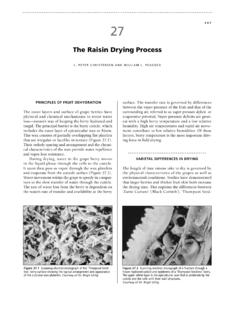Transcription of A Raisin in the Sun Rhetorical Devices
1 A Raisin in the Sun: Rhetorical Devices Museum Connection: Arts and Intellect Purpose: This lesson is designed to challenge students to discuss how Asagai uses the resources of language to present his point of view to Beneatha. The final analysis question is similar to those found on the Advanced Placement English Examinations. Course: American Literature Time Frame: 45-60 minute class Correlation to State Standards: Standard 1: The student will comprehend and interpret a variety of print, non-print, and electronic texts, and other media. Indicator The student will comprehend and interpret a variety of texts, including fiction, nonfiction, poetry, drama, and informational texts ( , articles, editorials, essays, speeches, literary criticism).
2 Objective The student will determine the contributions of literary elements in classical and contemporary literary texts. Standard 3: The student will compose in a variety of modes by developing content, employing specific forms, and selecting language appropriate for a particular audience and purpose. Indicator The student will compose written, oral, and multimedia presentations in a variety of formats and for a variety of audiences and purposes. The student will compose effective informative or expository texts ( , literary analysis and other academic compositions and essays; descriptions; summaries; world-related texts ( , brochure, proposals, project plans, resumes).)
3 Page 1 of 14 Maryland State Common Core Standards: RL1 Cite strong and thorough textual evidence to support analysis of what the text says explicitly as well as inferences drawn from the text, including determining where the text leaves matters uncertain. I6 Determine an author s point of view or purpose in a text in which the rhetoric is particularly effective, analyzing how style and content contribute to the power, persuasiveness, or beauty of the text. W1 Write arguments to support claims in an analysis of substantive topics or texts, using valid reasoning and relevant and sufficient evidence.
4 W4 Produce clear and coherent writing in which the development, organization, and style are appropriate to task, purpose, and audience. Objective: Students will complete a close reading of Asagai s speech to Beneatha in order to analyze the effect of Rhetorical Devices on a speaker s message. Vocabulary and Concepts: Word or Concept Definition Absolute A word free from limitations or qualifications Alliteration The repetition of initial sounds in successive or neighboring words. Allusion A reference to something literary, mythological, or historical that the author assumes the reader will recognize.
5 Analogy A comparison that points out similarities between two dissimilar things. Anaphora Repetition of words or phrases at the beginning of consecutive lines or sentences. Anecdote A brief narrative often used to illustrate an idea or make a point. Aphorism A short, pithy statement that expresses succinctly a general truth or idea, often using rhyme or balance. Also called adage or maxim. Asyndeton A construction in which elements are presented in a series without conjunctions. Diction Purposeful choice of words Page 2 of 14 Ellipsis Three periods used to indicate a pause in speech, an unfinished thought, or, at the end of a sentence, a trailing off into silence to inspire a feeling of melancholy longing.
6 Ethos The element in literature that appeals to beliefs, morals, habit, and attitudes, often of the speaker. Exclamation An abrupt, forceful utterance Figurative In contrast to literal language, figurative language implies meanings. Imagery Language that appeals to the senses. Literal In contrast to figurative language, language that adheres to the primary meaning. Logos The element in literature that appeals to reason; focus is on the content of the text. Metaphor A direct comparison of two different things.
7 Parallelism The use of identical or equivalent syntactic constructions in corresponding clauses or phrases for Rhetorical effect Paradox A statement that seems self-contradictory but is, nevertheless, true. Pathos That element in literature that stimulates pity or sorrow from the reader or audience. Personification Endowing non-human objects or creatures with human qualities or characteristics. Polysyndeton The use of more conjunctions than is necessary or natural Pun A play on words that are identical or similar in sound but have sharply diverse meanings.
8 Repetition Deliberate reuse of the same sounds, words, phrase, or ideas for effect, usually to emphasize a point. Rhetorical question A question to which the audience already knows the answer; a question asked merely for effect with no answer expected. Synecdoche A form of metaphor that utilizes a part as a representative or whole. Materials: For the Teacher: Teacher Resource Sheet 1: SOAPSTone for Beneatha and Asagai--Key Teacher Resource Sheet 2: Rhetorical Analysis Page 3 of 14 For the Student: Student Resource Sheet 1: SOAPSTone for Beneatha and Asagai--Key Student Resource Sheet 2: Rhetorical Analysis Student Resource Sheet 3: Timed Writing Resources: Publications: Hansberry, Lorraine.
9 A Raisin in the Sun: a Drama in Three Acts. New York: Random House, 1959. Print. Holman, C. Hugh, William Harmon, and William Flint Thrall. A Handbook to Literature. New York: Macmillan, 1986, Print. The AP Vertical Teams Guide for English. [New York]: College Entrance Examination Board, 2002. Print. Web Sites: For famous speeches: For information on Lorraine Hansberry: assimilationFor information on cultural assimilation: Historical Background: Lorraine Vivian Hansberry was born on May 19, 1930 in Chicago, Illinois. Her grandparents were freed slaves.
10 Her father was a successful real estate broker and banker, while her mother was a schoolteacher. Lorraine s parents were active in the black community, including the National Association of Colored People (NAACP) and Urban League. When Lorraine was eight years old, her parents moved to Washington Park, a predominately white neighborhood. Because of the long practice of segregation and the restrictive covenant that the neighborhood had against integration, her family was violently attached by neighbors. A mob even threw bricks into their home, nearly hitting Lorraine in the head.








